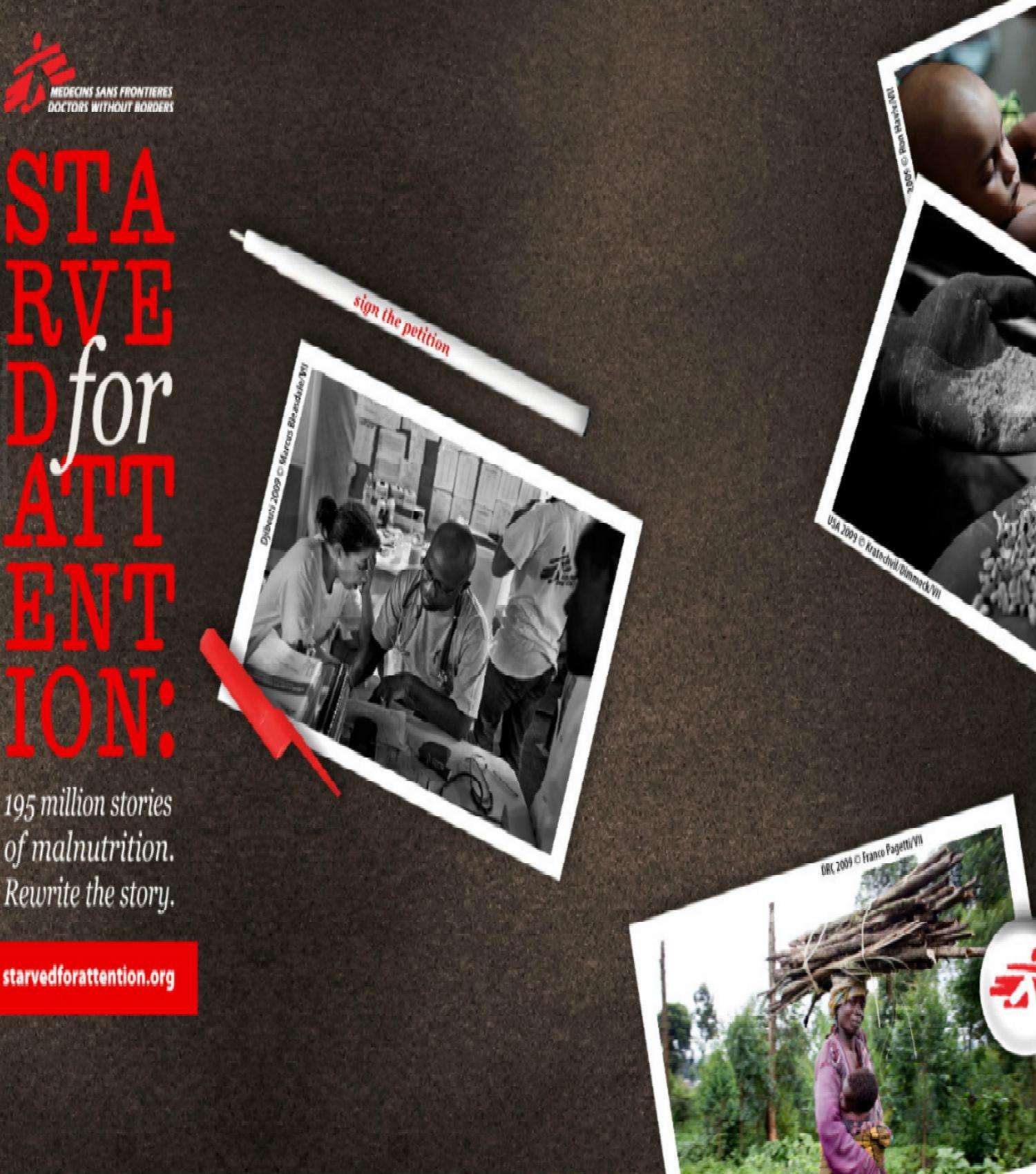Starved for Attention: A Radical New Vision Of Malnutrition
MSF international multimedia campaign to rewrite the story of childhood malnutrition
90% of our funding comes from individual donors. Learn how you can support MSF’s lifesaving care with a gift.
MSF international multimedia campaign to rewrite the story of childhood malnutrition

USA 2012 © MSF-USA
NEW YORK—The international medical humanitarian organization Doctors Without Borders/Médecins Sans Frontières (MSF) and the VII Photo agency today launched “Starved for Attention,” a global multimedia campaign presenting a unique and new perspective of childhood malnutrition, a preventable and treatable condition that nonetheless claims the lives of millions of children each year.
The collaboration challenges established notions of malnutrition through a seven-part mini-documentary series; clichéd images are substituted with those of parents and health workers struggling to meet the nutritional needs of young, growing children. Starved for Attention highlights how increased childhood sickness and early death can be prevented with effective nutritional interventions. The campaign launch coincides with the onset of a particularly harsh “hunger gap” season in Africa’s Sahel region, the period when staple food crops run out before the next harvest and malnutrition typically increases.
The documentaries will be released over a seven-week period beginning today at: www.starvedforattention.org
“Documenting malnutrition has been one of the toughest challenges our agency has faced,” said VII Photographer Ron Haviv. “There is a sense that this story has already been told through the body of work produced by photojournalists who covered famines of the 20th century. Yet we believe that we have found a completely new visual language to tell this story—one that has the potential for great impact.”
At any given time, an estimated 195 million children are affected by malnutrition worldwide. It contributes to at least one-third of the eight million annual deaths of children under five years of age. These deaths are preventable if the nutritional requirements of young children are met. Starved for Attention underscores the possible, focusing on successful strategies implemented daily to address malnutrition, and how they can, and must, be expanded.
The most vulnerable are children up to two years of age, whose nutritional needs are especially high. If children in that time-frame do not receive quality foods that provide balanced nutrition, they face stunting, cognitive impairment, and increased vulnerability to disease. At worst, they can face early death.
“Our medical teams working in more than 30 countries with high levels of malnutrition, in sub-Saharan Africa and South Asia, have demonstrated that with early intervention with quality, balanced foods, countless children can be spared the consequences of malnutrition,” said Dr. Christophe Fournier, president of MSF’s International Council “We know what children need. It’s simply a matter of ensuring they get it.” In 2009, MSF treated 250,000 malnourished children in 34 countries.
VII photojournalists Marcus Bleasdale, Jessica Dimmock, Ron Haviv, Antonin Kratochvil, Franco Pagetti, Stephanie Sinclair, and John Stanmeyer contributed to Starved for Attention. They traveled to rural villages, war zones, teeming capitals, and mountain hideaways to document childhood malnutrition and its varied faces: the incongruity of malnourished children in lush and bountiful Congo; the cyclical nature of malnutrition in Bangladesh; the impact of the annual “lean season” in the Sahel. Highlighting successful treatment and prevention programs in countries like Mexico and the United States, Starved for Attention emphasizes the great potential for combating early childhood malnutrition.
The Starved for Attention campaign seeks to build a critical mass of awareness that will translate into reforms of humanitarian food assistance and nutrition programs for malnourished children, and the mobilization of resources needed to scale up programs to prevent and treat malnutrition. Visitors to starvedforattention.org can add their names to a global petition drive titled “Overcoming Childhood Malnutrition: The Time to Act is Now.”
Currently, international food donors mostly provide cereal-based fortified flours. While these foods can relieve hunger, they do not meet the nutritional requirements of young, growing children. For example, the US, the world’s largest food aid donor, is sending sub-standard foods that do not meet basic nutrition requirements for infants and young children. These foods would not be provided to children in the US. Starved for Attention exposes this double standard.
Tested strategies to address malnutrition are effective and are showing promising results in many countries. Some, including Mexico, Thailand, and Brazil, have reduced early childhood malnutrition through direct nutrition programs that ensure infants and young children from even the poorest families have access to quality foods, such as milk and eggs. At the same time there is growing political will in Asian and African countries to replicate successful programs. The Starved for Attention petition calls for support to these efforts.
Along with the multilingual website, the global campaign launches in New York City tonight with an exhibit and panel discussion event, followed by an exhibit at the VII Gallery in Brooklyn, New York. The multimedia exhibit will travel to Toronto, Milan, and Rome, among others.
Tonight’s event will be webcast at:
http://www.livestream.com/starvedforattention
Starved for Attention is made possible with the support of LG Electronics, which has provided financial support and its latest generation INFINIA flat panel television screens to display the project’s documentaries in exhibitions.
© Médecins Sans Frontières 2024 Federal tax ID#: 13-3433452
Unrestricted donations enable MSF to carry out our programs around the world. While we try to honor requests to earmark, should we receive more gifts than we can use for a program, we will reallocate them where the needs are greatest.
For Donors
For Supporters
For Media
For Recruits
General Interest
© Médecins Sans Frontières 2024 Federal tax ID#: 13-3433452
Unrestricted donations enable MSF to carry out our programs around the world. While we try to honor requests to earmark, should we receive more gifts than we can use for a program, we will reallocate them where the needs are greatest.
Your gift helps us provide medical humanitarian aid for hundreds of thousands of people each year.
Learn more87%
Programs
12%
Fundraising
1%
Management & General Admin

We need your support to continue this lifesaving work.